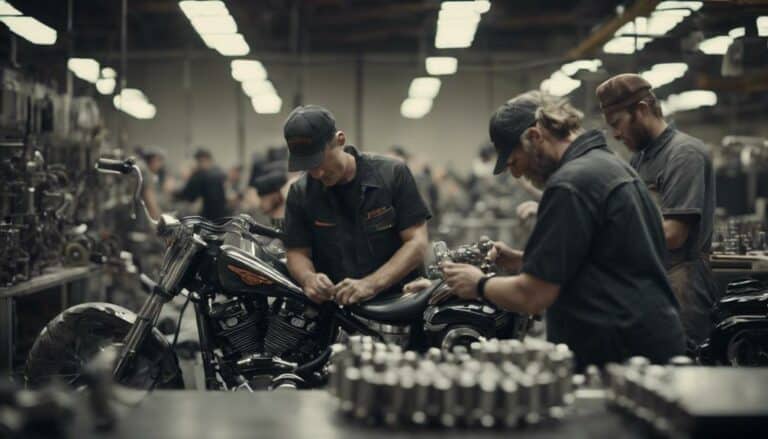When it comes to Harley-Davidson bikes, have you ever wondered about the intricate web of expertise behind their creation?
The process of who exactly is involved in crafting these iconic motorcycles might surprise you.
Let's shed some light on the skilled hands and innovative minds that collaborate to bring these legendary machines to life.
Key Takeaways
- Harley Davidson bikes are made in the U.S. at plants in Wisconsin and Pennsylvania.
- V-twin engines for Harley Davidson bikes are crafted in Milwaukee, Wisconsin.
- Global parts sourcing from countries like Japan, Italy, and Mexico ensures quality.
- Expansion plans include new plants in Thailand, India, and Brazil for global production.
Founders of Harley-Davidson
Harley-Davidson, a renowned motorcycle manufacturer, was founded by William S. Harley and Arthur Davidson in 1903, marking the beginning of a legacy in the industry. William S. Harley, the chief engineer, was instrumental in the development of the two-cylinder engine, a significant innovation that set Harley-Davidson apart in terms of performance. In parallel, Arthur Davidson, the general sales manager, forged crucial partnerships with entities like USPS, police departments, and the military, laying the foundation for the brand's widespread recognition and success.
The incorporation of Harley-Davidson in 1907 solidified the commitment of its founders to building a lasting and influential company. William S. Harley and Arthur Davidson's vision and expertise complemented each other perfectly, allowing them to create motorcycles that not only met the demands of the time but also set new standards in the industry. Through strategic alliances with key institutions like the USPS and law enforcement agencies, Harley-Davidson motorcycles became synonymous with reliability, power, and performance, establishing a solid reputation that endures to this day.
Evolution of Harley-Davidson Brand
With a legacy rooted in innovation and endurance, the evolution of the renowned Harley-Davidson brand showcases a relentless commitment to pushing boundaries and setting new standards in the industry.
- Iconic Models: From the classic Knucklehead to the modern Milwaukee-Eight engines, Harley-Davidson has consistently introduced iconic models that have shaped the motorcycle industry.
- Military Involvement: With a rich history of military involvement, Harley-Davidson played a crucial role during World War II, supplying over 90,000 military motorcycles and earning accolades for excellence in production.
- Brand Resilience: Despite facing financial crises and allegations of stock price manipulation, Harley-Davidson has upheld its position as a global motorcycle manufacturer, emphasizing its heritage and brand identity to maintain a loyal customer base worldwide.
The brand's ability to innovate, diversify its product range, and navigate challenges underscores its enduring presence and influence in the motorcycle market.
Manufacturing Processes of Harley-Davidson
Amidst the legacy of innovation and endurance in the Harley-Davidson brand, the manufacturing processes of their iconic motorcycles showcase a meticulous fusion of American-made parts and global sourcing. Harley-Davidson proudly manufactures its bikes in the U.S, with plants in Wisconsin and Pennsylvania playing key roles in the production. The heart of these motorcycles, the V-twin engines, are meticulously crafted in Milwaukee, Wisconsin, emphasizing the brand's American roots. By assembling American-made parts, Harley-Davidson ensures that each bike reflects a commitment to quality and authenticity.
While the core components are American-made, Harley-Davidson also leverages global supply chains to source various parts. From countries like Japan, Italy, and Mexico, components are sourced to complement the American craftsmanship, creating a harmonious blend of local and international expertise. This strategic approach allows Harley-Davidson to maintain its reputation for quality while adapting to the complexities of a global market. Embracing modern manufacturing processes, the brand continues to deliver motorcycles that embody the spirit of American ingenuity and craftsmanship.
Supply Chain of Harley-Davidson
In the intricate web of global sourcing that fuels the production of Harley-Davidson motorcycles, a complex supply chain network intertwines various countries, including the U.S., Japan, Italy, Mexico, China, and Australia. This global approach to parts sourcing ensures that Harley-Davidson can access the best components from around the world, optimizing the quality of their bikes. The manufacturing operations of Harley-Davidson are strategically distributed, with bike assembly taking place in Kansas City and York, while engines are crafted in Milwaukee, reflecting a meticulous division of labor within the supply chain.
Key Points:
- Harley-Davidson is expanding its international presence by establishing manufacturing plants in Thailand, India, and Brazil, indicating a strategic shift towards a more globally diversified production network.
- The imposition of EU tariffs on U.S. products has prompted Harley-Davidson to relocate some of its production overseas, highlighting the impact of trade policies on supply chain decisions.
- The majority of Harley-Davidson's supply chain is now international, shaping its production processes and operational strategies on a global scale.
Ownership of Harley-Davidson Today
In the realm of Harley-Davidson's contemporary landscape, the intricate corporate structure entails a diverse array of shareholders actively participating in the ownership of the renowned motorcycle company. Harley-Davidson, a publicly-traded company in the U.S, boasts a wide range of ownership with institutional investors, individual investors, and mutual funds all holding stakes in the company.
This blend of ownership reflects a dynamic composition that contributes to the stability and growth of the company. The ownership structure of Harley-Davidson isn't static; rather, it mirrors the fluctuations in the stock market and the ever-changing sentiments of investors. The company's presence in the stock market attracts a mix of investors, each playing a role in shaping the ownership landscape.
Conclusion
As you reflect on the intricate web of global manufacturing that brings Harley-Davidson bikes to life, imagine each part coming together like a symphony of precision and passion.
The founders' vision has evolved into a timeless brand known for its iconic motorcycles. With a supply chain spanning across different countries, Harley-Davidson continues to ride the winds of change while staying true to its legacy of quality and craftsmanship.
So, next time you see a Harley-Davidson bike, remember the journey it took to reach you.

